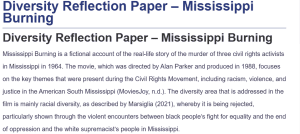Diversity Reflection Paper – Mississippi Burning
Mississippi Burning is a fictional account of the real-life story of the murder of three civil rights activists in Mississippi in 1964. The movie, which was directed by Alan Parker and produced in 1988, focuses on the key themes that were present during the Civil Rights Movement, including racism, violence, and justice in the American South Mississippi (MoviesJoy, n.d.). The diversity area that is addressed in the film is mainly racial diversity, as described by Marsiglia (2021), whereby it is being rejected, particularly shown through the violent encounters between black people’s fight for equality and the end of oppression and the white supremacist’s people in Mississippi.
Firstly, the cultural voice in Mississippi Burning was present, but it was also skewed. The film mainly portrays the culture, especially the blatant racism, through the lens of white people. It ignores the perspective of the black people who were highly influenced by the culture back then, especially due to the Civil Rights Movement, which was at its peak. White authority figures, especially law enforcement agencies, take the central role as the heroes, while black people and their voices are underrepresented, mainly being portrayed as victims. This is contrary to what the culture was back with black people being their own heroes with prominent leaders like Martin King Luther Jr., while white people were mainly in opposition, and a small percentage were allies of the movement. While the struggles of black people are well depicted, their voices are not central to the story, which leads to marginalization that overlooks the pivotal role that black people had in creating their own narrative during this period. As such, the cultural voice during the 1960s is only partially included in the film, dominated by the viewpoint of white law enforcement and villains.
The film perpetuates several racial and cultural stereotypes, which could easily influence an audience that is unfamiliar with the history of the period as well as black and white people in America. First, there is the depiction of black people as helpless victims who were fearful and powerless while facing white supremacy. While white supremacy and its violence were horrible, the film fails to depict the energy and brave activism of not only authority figures but also ordinary black people who sought equality and battled despite the danger to their lives. By focusing primarily on the white characters, the film then reduces black people to the generalized role of passive bystanders rather than protagonists in their own struggles.
The film also depicts white people as racist, violent, and ignorant, and while this depiction is true for most white supremacists, the film does little to showcase white people who were also allies of the civil rights movement and fought alongside black people. There is a one-dimensional portrayal of white people as being white supremacists, and this can reinforce the stereotype that all white people are racist. By only portraying these two groups in a stereotypical and unidimensional way, the movie risks reinforcing risky stereotypes, especially to those with little knowledge of these cultures.
Undeniably, this movie does a great job of capturing the intense racial tension of the time and the violence that black people constantly faced, for example, murders, physical violence, and the burning of churches, among others. These scenes evoked some intense emotions in me as a viewer, especially the scenes that contained racial violence, injustices, and hatred. Nevertheless, there is also the feeling of disappointment because white saviorism seems to be the central theme of the movie as opposed to the struggle and fight for equality by black people, and instead, they are just side characters in a story that centered around them. As such, not putting black people and their courageous and relentless fight was a missed opportunity.
References
Marsiglia, F. F., Kulis, S. S., & Lechuga-Peña, S. (2021). Diversity, oppression, and change: Culturally grounded social work. Oxford University Press, USA.
MoviesJoy. (n.d.). Mississippi Burning. Moviestojoy. https://moviesjoy.is/movie/mississippi-burning-18091.
ORDER A PLAGIARISM-FREE PAPER HERE
We’ll write everything from scratch
Question 
Readings:
- Textbook:
- Videos:
Write a two-page reflection paper to review each of the movies/documentaries.

Diversity Reflection Paper – Mississippi Burning
Must include: the title of the film, year produced, and what area of diversity is addressed.
Please select THREE (or more) key points to address:
- *Was the voice of the culture included in the movie/documentary?
- *cultural differences than own culture, issues of race, gender issues, religious issues, age discrimination, physical or mental ability or other difference.
- *cultural impact of service delivery, significance in social interaction, disadvantages subculture
- *challenges on a micro, macro, mezzo level of social work practice and counter those challenges with potential solutions to be explored.
- *Identify and deconstruct stereotypical images associated with the racial/ethnic group and how this effects stereotypes on others outside that culture.
- *How does the movie/documentary reflect the Ethical Standard 1.05 (Cultural Awareness and Social Diversity). You can review NASW Ethnicity and Race issues at https://www.socialworkers.org/Practice/Ethnicity-Race
- *address feelings of how the movie/documentary made you feel.
